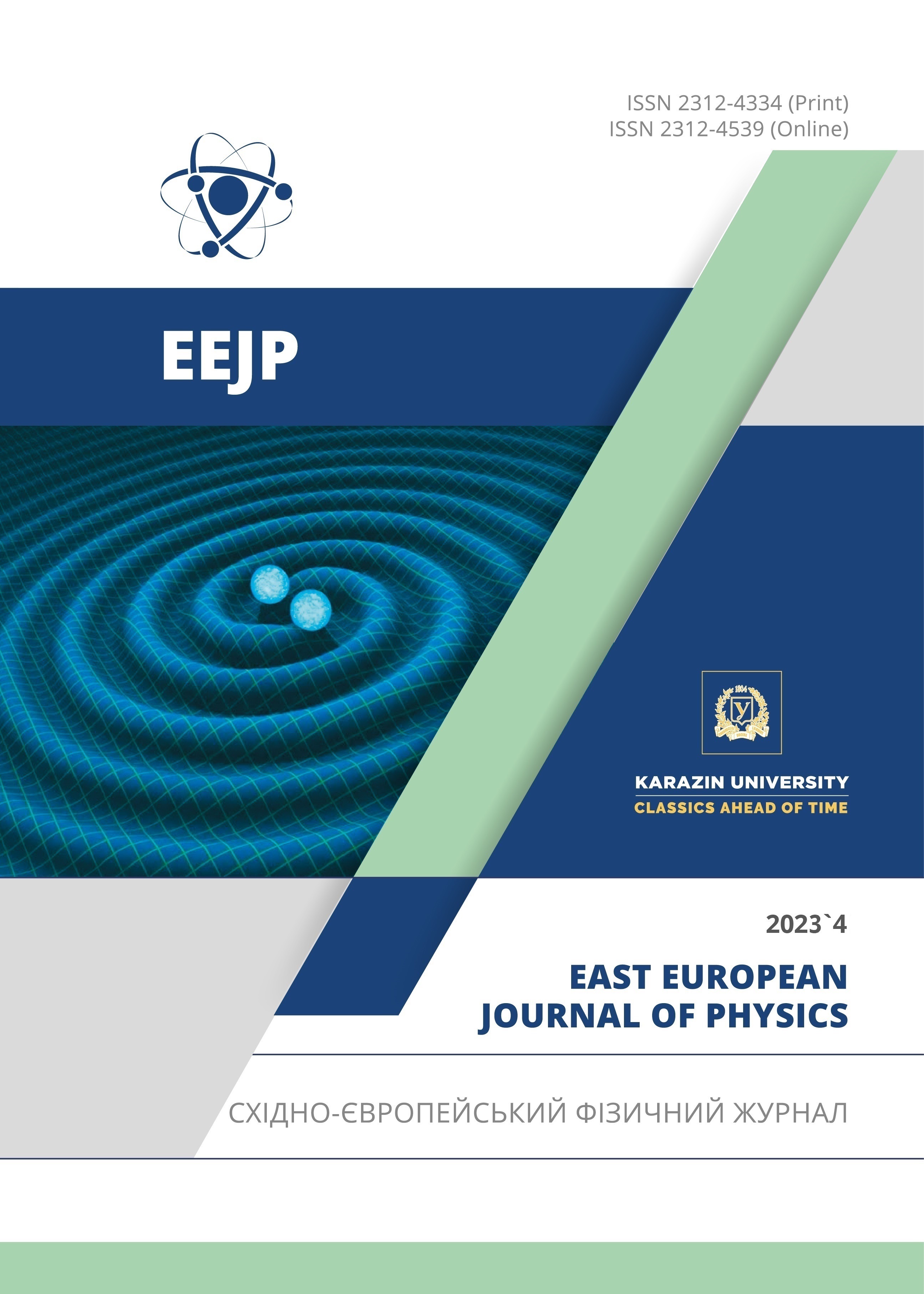Estimation of Nuclear Mass Formulas Coefficients Using Least-Squares Method Based on Gauss-Seidel Scheme: A Comparative Study Between Three Models
Abstract
This paper presents the analysis and implementation of the least-squares method based on the Gauss-Seidel scheme for solving nuclear mass formulas. The least-squares method leads to the solution of the system by iterations. The main advantages of the discussed method are simplicity and high accuracy. Moreover, the method enables us to process large data quickly in practice. To demonstrate the effectiveness of the method, implementation using the FORTRAN language is carried out. The steps of the algorithm are detailed. Using 2331 nuclear masses with Z ≥ 8 and N ≥ 8, it was shown that the performance of the liquid drop mass formula with six parameters improved in terms of root mean square (r.m.s. deviation equals 1.28 MeV), compared to the formula of liquid drop mass with six parameters without microscopic energy, deformation energy and congruence energy (r.m.s. deviation equals 2.65 MeV). The nuclear liquid drop model is revisited to make explicit the role of the microscopic corrections (shell and pairing). Deformation energy and the congruence energy estimate have been used to obtain the best fit. It is shown that the performance of the new approach is improved by a model of eight parameters, compared to the previous model of six parameters. The obtained r.m.s. result for the new liquid drop model in terms of masses is equal to 1.05 MeV.
Downloads
References
P. M¨oller, and A.J. Sierk, International Journal of Mass Spectrometry, 349–350, 19 (2013). https://doi.org/10.1016/j.ijms.2013.04.008.
W.D. Myers, and W.J. ´Swi¸atecki, Nuclear Physics, 81, 1 (1966). https://doi.org/10.1016/0029-5582(66)90639-0.
V.M. Strutinsky, Nuclear Physics A, 95, 420 (1967). https://doi.org/10.1016/0375-9474(67)90510-6.
P. M¨oller, J.R. Nix, W.D. Myers, and W.J. ´Swi¸atecki, “Nuclear Ground-State Masses and Deformations,” Atomic Data Nucl. Data Tables, 185-381, 59 (1995).
W.D. Myers and W.J. ´Swi¸atecki, Nuclear Physics A, 601, 141 (1996). https://doi.org/10.1016/0375-9474(95)00509-9.
A.K. Dutta, J.-P. Arcoragi, J.M. Pearson, R. Behrman, and F. Tondeur, Nuclear Physics A, 458, 77 (1986). https://doi.org/10.1016/0375-9474(86)90283-6.
K. Pomorski and J. Dudek, Phys. Rev. C, 67, (2003). https://doi.org/10.1103/PhysRevC.67.044316.
S. Goriely, N. Chamel, and J.M. Pearson, Phys. Rev. C, 82, (2010). https://doi.org/10.1103/physrevc.82.035804.
S. Goriely, S. Hilaire, M. Girod, and S. P´eru, Phys. Rev. Lett. 102, (2009). https://doi.org/10.1103/physrevlett.102.242501.
J. Duflo, and A.P. Zuker, Phys. Rev. C, 52, R23 (1995). https://doi.org/10.1103/physrevc.52.r23.
H. Koura, T. Tachibana, M. Uno, and M. Yamada, Progress of Theoretical Physics, 113, 305 (2005). https://doi.org/10.1143/ptp.113.305.
C.F.V. Weizsacker, Z. Physik, 96, 431 (1935). https://doi.org/10.1007/bf01337700.
J. Bleck-Neuhaus, Elementare Teilchen, (Springer Berlin Heidelberg, 2010), https://doi.org/10.1007/978-3-540-85300-8.
ZEUS Collaboration, M. Derrick, et al., Z. Phys. C - Particles and Fields, 63, 391 (1994), https://doi.org/10.1007/bf01580320.
A. Bohr, B.R. Mottelson, and D. Pines, Phys. Rev. 110, 936 (1958), https://doi.org/10.1103/physrev.110.936.
S.G. Nilsson, C.F. Tsang, A. Sobiczewski, Z. Szyma´nski, S. Wycech, C. Gustafson, I.-L. Lamm, P. M¨oller, and B. Nilsson, Nuclear Physics A, 131, 1 (1969), https://doi.org/10.1016/0375-9474(69)90809-4.
H. Olofsson, S. ˚Aberg, and P. Leboeuf, Phys. Rev. Lett. 100, (2008), https://doi.org/10.1103/physrevlett.100.037005.
M. Brack, and P. Quentin, Physics Letters B, 56, 421 (1975), https://doi.org/10.1016/0370-2693(75)90401-3.
G.G. Bunatian, V.M. Kolomietz, and V.M. Strutinsky, Nuclear Physics A, 188, 225 (1972), https://doi.org/10.1016/0375-9474(72)90058-9.
D. Lunney, J.M. Pearson, and C. Thibault, Rev. Mod. Phys. 75, 1021 (2003), https://doi.org/10.1103/revmodphys.75.1021.
F.F.A. Al-dawdy, and F.M.A. Al-jomaily, Arab Journal of Nuclear Sciences and Applications, 55, 150 (2022), https://doi.org/10.21608/ajnsa.2022.135860.1574.
F. Al-jomaily and R. Abdullateef, Arab Journal of Nuclear Sciences and Applications, 55, 62 (2021), https://doi.org/10.21608/ajnsa.2021.75297.1471.
B. Mohammed-Azizi, Int. J. Mod. Phys. C, 21, 681 (2010), https://doi.org/10.1142/s0129183110015415.
M.M.A. Vahid, M. Mohsen, A.M. Bagher, Nuclear Science, 2, 11 (2010), https://doi.org/10.11648/j.ns.20170201.13.
S.Cht. Mavrodiev, Nuclear Theory, edited by M. Gaidarov, and N. Minkov, (HeronPress, Sofia, 2016). 35, 288 (2016).
H. Zhang, J. Dong, N. Ma, G. Royer, J. Li, and H. Zhang, Nuclear Physics A, 929, 38 (2014), https://doi.org/10.1016/j.nuclphysa.2014.05.019.
B. Mohammed-Azizi and H. Mouloudj, Int. J. Mod. Phys. C, 33, (2021), https://doi.org/10.1142/s0129183122500760.
H.R. Vega-Carrillo, and H. Ren´e, Revista Mexicana de F´ısica, 35(4), 591 (1989), https://doi.org/10.48779/0egn-1c86.
P.R. Chowdhury, C. Samanta, and D.N. Basu, Mod. Phys. Lett. A, 20, 1605 (2005), https://doi.org/10.1142/s021773230501666x.
H.A. Bethe, and R.F. Bacher, Rev. Mod. Phys. 8, 82 (1936), https://doi.org/10.1103/RevModPhys.8.82.
S.M. Stigler, Ann. Statist. 9, (1981), https://doi.org/10.1214/aos/1176345451.
P.C. Hansen, V. Pereyra, and G. Scherer. Handbook of Least Squares Data Fitting with Applications, (Johns Hopkins University Press, 2013)
P. M¨oller, A.J. Sierk, T. Ichikawa, and H. Sagawa, Atomic Data and Nuclear Data Tables, 109–110, 1 (2016), https://doi.org/10.1016/j.adt.2015.10.002.
G. Royer, Nuclear Physics A, 807, 105 (2008), https://doi.org/10.1016/j.nuclphysa.2008.04.002.
W.D. Myers, Droplet Model of Atomic Nuclei, (Plenum Publishing Corporation, 1977). https://escholarship.org/content/qt7bn59935/qt7bn59935.pdf
Atomic Mass Data Center AMDC, International Atomic Energy Agency - Nuclear Data Section, https://www-nds.iaea.org/amdc/
Copyright (c) 2023 Hadj Mouloudj, Benyoucef Mohammed-Azizi, Oussama Zeggai, Abdelkader Ghalem, Alla Eddine Toubal Maamar

This work is licensed under a Creative Commons Attribution 4.0 International License.
Authors who publish with this journal agree to the following terms:
- Authors retain copyright and grant the journal right of first publication with the work simultaneously licensed under a Creative Commons Attribution License that allows others to share the work with an acknowledgment of the work's authorship and initial publication in this journal.
- Authors are able to enter into separate, additional contractual arrangements for the non-exclusive distribution of the journal's published version of the work (e.g., post it to an institutional repository or publish it in a book), with an acknowledgment of its initial publication in this journal.
- Authors are permitted and encouraged to post their work online (e.g., in institutional repositories or on their website) prior to and during the submission process, as it can lead to productive exchanges, as well as earlier and greater citation of published work (See The Effect of Open Access).








